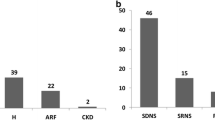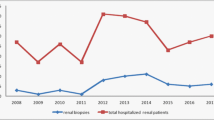Abstract
Background
Pediatric native kidney diseases are common worldwide. The pathological diagnosis of kidney lesions is crucial for clinical treatment and prognosis. The aim of the current study was therefore to evaluate the value of electron microscopy (EM) to the final diagnosis of native kidney biopsies in children.
Methods
A retrospective evaluation of 855 pediatric kidney biopsies obtained from the Department of Pediatrics in Peking University First Hospital between November 2010 and December 2017 was performed to assess the contribution of EM to the final diagnosis.
Results
The role of EM in the final diagnosis was determined to be crucial in 300 cases (35.1%), important in 280 cases (32.7%), and auxiliary in 275 cases (32.2%). EM is considered most valuable in a large percentage of glomerular diseases, mainly including minimal change disease, early-stage membranous nephropathy, postinfectious glomerulonephritis, Alport syndrome, thin basement membrane nephropathy, and thrombotic microangiopathy. EM also provided helpful diagnostic information in cases of focal segmental glomerulosclerosis, lupus nephritis, IgA nephropathy, and IgA vasculitis (Henoch-Schonlein purpura nephritis). Additionally, EM was crucial in 90.0% of cases of subtle pathological changes observed with light microscopy (LM) and immunofluorescence (IF) and in 69.3% of the IF-negative specimens. Patients with nephrotic syndrome or hematuria also benefit from ultrastructural examination.
Conclusions
The present study demonstrated the crucial or important role of EM in the diagnosis of a majority of native kidney biopsies in children. The application of EM should be integrated together with LM and IF as a routine method of assessing pediatric kidney specimens.

Graphical abstract





Similar content being viewed by others
Data availability
The datasets generated and analyzed in the current study are available from the corresponding author upon reasonable request.
References
Wenderfer SE, Gaut JP (2017) Glomerular diseases in children. Adv Chronic Kidney Dis 24:364–371
McEwen ST, Rheault MN (2020) Glomerular disease in children: when to biopsy. Nephrol Dial Transplant. https://doi.org/10.1093/ndt/gfz280
Vivarelli M, Massella L, Ruggiero B, Emma F (2017) Minimal change disease. Clin J Am Soc Nephrol 12:332–345
Nozu K, Nakanishi K, Abe Y, Udagawa T, Okada S, Okamoto T, Kaito H, Kanemoto K, Kobayashi A, Tanaka E, Tanaka K, Hama T, Fujimaru R, Miwa S, Yamamura T, Yamamura N, Horinouchi T, Minamikawa S, Nagata M, Iijima K (2019) A review of clinical characteristics and genetic backgrounds in Alport syndrome. Clin Exp Nephrol 23:158–168
Tighe JR, Jones NF (1970) The diagnostic value of routine electron microscopy of renal biopsies. Proc R Soc Med 63:475–477
Spargo BH (1975) Practical use of electron microscopy for the diagnosis of glomerular disease. Hum Pathol 6:405–420
Haas M (1997) A reevaluation of routine electron microscopy in the examination of native renal biopsies. J Am Soc Nephrol 8:70–76
Collan Y, Hirsimaki P, Aho H, Wuorela M, Sundstrom J, Tertti R, Metsarinne K (2005) Value of electron microscopy in kidney biopsy diagnosis. Ultrastruct Pathol 29:461–468
Elhefnawy NG (2011) Contribution of electron microscopy to the final diagnosis of renal biopsies in Egyptian patients. Pathol Oncol Res 17:121–125
Mokhtar GA, Jallalah SM (2011) Role of electron microscopy in evaluation of native kidney biopsy: a retrospective study of 273 cases. Iran J Kidney Dis 5:314–319
Zuppan C (2011) Role of electron microscopy in the diagnosis of nonneoplastic renal disease in children. Ultrastruct Pathol 35:240–244
Jahanzad I, Mehrazma M, Makhmalbaf AO (2011) The role of electron microscopy for the diagnosis of childhood glomerular diseases. Iran J Pediatr 21:357–361
Wang F, Zhang Y, Mao J, Yu Z, Yi Z, Yu L, Sun J, Wei X, Ding F, Zhang H, Xiao H, Yao Y, Tan W, Lovric S, Ding J, Hildebrandt F (2017) Spectrum of mutations in Chinese children with steroid-resistant nephrotic syndrome. Pediatr Nephrol 32:1181–1192
Holle J, Berenberg-Gossler L, Wu K, Beringer O, Kropp F, Muller D, Thumfart J (2018) Outcome of membranoproliferative glomerulonephritis and C3-glomerulopathy in children and adolescents. Pediatr Nephrol 33:2289–2298
Nieuwhof C, Doorenbos C, Grave W, de Heer F, de Leeuw P, Zeppenfeldt E, van Breda Vriesman PJ (1996) A prospective study of the natural history of idiopathic non-proteinuric hematuria. Kidney Int 49:222–225
Churg JBJ, Glassock RJ (1995) World Health Organization (WHO) monograph. Renal disease: classification and atlas of glomerular diseases, 2nd edn. Igaku-Shoin, Tokyo
Rivera A, Magliato S, Meleg-Smith S (2001) Value of electron microscopy in the diagnosis of childhood nephrotic syndrome. Ultrastruct Pathol 25:313–320
Zurawski J, Burchardt P, Seget M, Moczko J, Wozniak A, Grochowalski M, Salwa-Zurawska W (2016) Difficulties in differentiating thin basement membrane disease from Alport syndrome. Pol J Pathol 67:357–363
Fogo AB, Lusco MA, Najafian B, Alpers CE (2016) AJKD atlas of renal pathology: thin basement membrane lesion. Am J Kidney Dis 68:e17–e18
Fogo AB, Lusco MA, Najafian B, Alpers CE (2016) AJKD atlas of renal pathology: Alport syndrome. Am J Kidney Dis 68:e15–e16
Sethi S, Zand L, Nasr SH, Glassock RJ, Fervenza FC (2014) Focal and segmental glomerulosclerosis: clinical and kidney biopsy correlations. Clin Kidney J 7:531–537
Sethi S, Glassock RJ, Fervenza FC (2015) Focal segmental glomerulosclerosis: towards a better understanding for the practicing nephrologist. Nephrol Dial Transplant 30:375–384
Howell DN, Gu X, Herrera GA (2003) Organized deposits in the kidney and look-alikes. Ultrastruct Pathol 27:295–312
Herrera GA, Turbat-Herrera EA (2010) Renal diseases with organized deposits: an algorithmic approach to classification and clinicopathologic diagnosis. Arch Pathol Lab Med 134:512–531
Mubarak M, Kazi J (2013) Study of nephrotic syndrome in children: importance of light, immunoflourescence and electron microscopic observations to a correct classification of glomerulopathies. Nefrologia 33:237–242
Kodner C (2016) Diagnosis and Management of Nephrotic syndrome in adults. Am Fam Physician 93:479–485
Larsen CP, Messias NC, Walker PD, Fidler ME, Cornell LD, Hernandez LH, Alexander MP, Sethi S, Nasr SH (2015) Membranoproliferative glomerulonephritis with masked monotypic immunoglobulin deposits. Kidney Int 88:867–873
Funding
This study was supported by Scientific Research Seed Fund of Peking University First Hospital (No. 2018SF008).
Author information
Authors and Affiliations
Contributions
X.Z. and S.X.W. contributed to the study conception and design; X.Z., J.X., H.J.X., Y.Y., F.W., X.H.Z., X.Y.L., and B.G.S. acquired and analyzed data; S.X.W. and J.D. supervised and mentored the manuscript; M.M.L. produced the artwork; X.Z., M.M.L., H.W., Y.L.R, M.C., and L.J.C. contributed intellectual content during the writing or revision of the manuscript and agreed to be accountable for all aspects of the work.
Corresponding author
Ethics declarations
This study was approved by the hospital institutional review boards. Informed consent was obtained from all individual participants involved in the study.
Conflict of interest
The authors declare that they have no conflict of interest.
Additional information
Publisher’s note
Springer Nature remains neutral with regard to jurisdictional claims in published maps and institutional affiliations.
Electronic supplementary material
ESM 1
(PPTX 83 kb).
Rights and permissions
About this article
Cite this article
Zhang, X., Xu, J., Xiao, H. et al. Value of electron microscopy in the pathological diagnosis of native kidney biopsies in children. Pediatr Nephrol 35, 2285–2295 (2020). https://doi.org/10.1007/s00467-020-04681-6
Received:
Revised:
Accepted:
Published:
Issue Date:
DOI: https://doi.org/10.1007/s00467-020-04681-6




